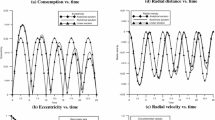Abstract
The paper regards two-impulse transfer from a low parking orbit into a circular orbit with the altitude less than 36 000 km, while the inclination correction is carried out with each maneuver. An approximate formula is proposed capable of evaluating analytically the optimal value of the first correction of inclination; the corresponding accuracy data are given. Examples are provided to show the operational efficiency of an optimal non-coplanar transfer of the type II with injections of satellites into various target orbits from Russian launch sites with due account of the available launch azimuths.
Similar content being viewed by others
References
Norbury, J.W., Perspective on Space Radiation for Space Flights in 2020–2040, Advances in Space Research, 2011, vol. 47, no. 4, pp. 611–621.
Hohmann, W., Die Erreichbarkeit der Himmelskörper. München, Berlin, Oldenbourg: Verlag, 1925.
Okhotsimskii, D.E. and Sikharulidze, Yu.G., Osnovy mekhaniki kosmicheskogo poleta (Fundamentals of Space Flight Mechanics), Moscow: Nauka, 1990.
Baranov, A.A., Manevrirovanie kosmicheskikh apparatov v okresnosti krugovoi orbity (Spacecraft Manoeuvres in the Vicinity of a Circular Orbit), Moscow: Sputnik+, 2016.
Ivashkin, V.V., Optimizatsiya kosmicheskikh manevrov pri ogranicheniyakh na rasstoyaniya do planet (Optimization of Space Manoeuvres under Constraints on Planets Distance), Moscow: Nauka, 1975.
Spacecraft Launches, Novosti Kosmonavtiki, 2014, vol. 24, no. 2 (373), p.63.
Komarov, I.A., Milovanov, A.G., and Chmarov, K.V., Vostochny Launch Site—the Future of Russian Spaceflight, Kosmicheskaya Tekhnika i Tekhnologii, 2015, no. 3(10), pp. 3–14.
Wood, L., Lou, Y., and Olusola, O., Revisiting Elliptical Satellite Orbits to Enhance the O3b Constellation, Journal of the British Interplanetary Society, 2014, vol. 67 (3), pp. 110–118.
Ivashkin, V.V. and Belousov, S.V., Trajectories for a Spacecraft Flight to Geostationary Orbit Using the Gravitational Field of the Moon, Izv. Vuz. Fizika, 2013, vol. 56, no. 6–3, pp. 214–216.
Ivashkin, V.V. and Golikov, A.R., “Detour” Trajectories for Spacecraft Flight between Earth and Geostationary Orbit Using Moon’s Gravity, Preprint of Keldysh Institute of Applied Mathematics, 2008, no.95.
Wiedemann, C., Bendisch, J., Krag, H., Wegener, P., and Rex, D., Modeling of Copper Needle Clusters from the West Ford Dipole Experiments, Proc. of the Third European Conference on Space Debris, 2001, Germany, Darmstadt, pp. 315–320.
Appazov, R.F. and Sytin, O.G., Metody proektirovaniya traektorii nositelei i sputnikov Zemli (Methods for Designing the Trajectories of Launch Vehicles and Earth Satellites), Moscow: Nauka, 1987.
Author information
Authors and Affiliations
Corresponding author
Additional information
Original Russian Text © D.A. Grishko, B.O. Vasil’kov, 2018, published in Izvestiya Vysshikh Uchebnykh Zavedenii, Aviatsionnaya Tekhnika, 2018, No. 3, pp. 35–41.
About this article
Cite this article
Grishko, D.A., Vasil’kov, B.O. On the Non-coplanar Transfer of Type II between Two Circular Orbits. Russ. Aeronaut. 61, 355–362 (2018). https://doi.org/10.3103/S1068799818030066
Received:
Published:
Issue Date:
DOI: https://doi.org/10.3103/S1068799818030066




